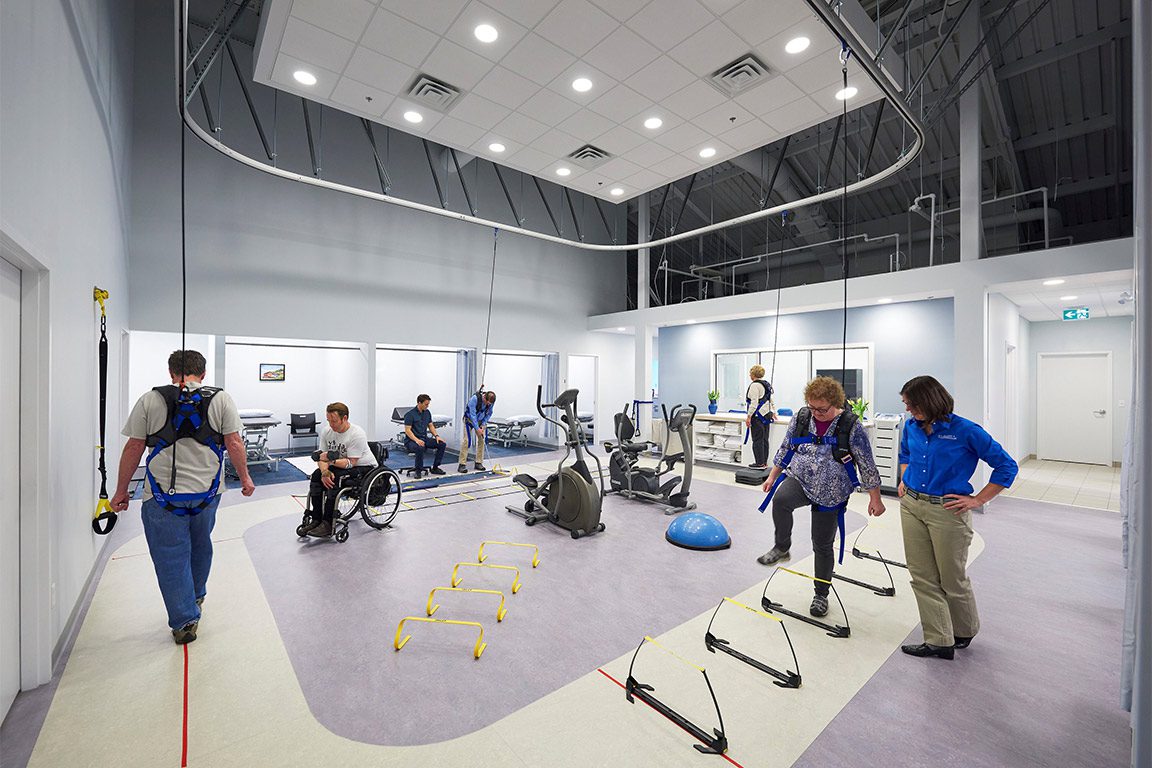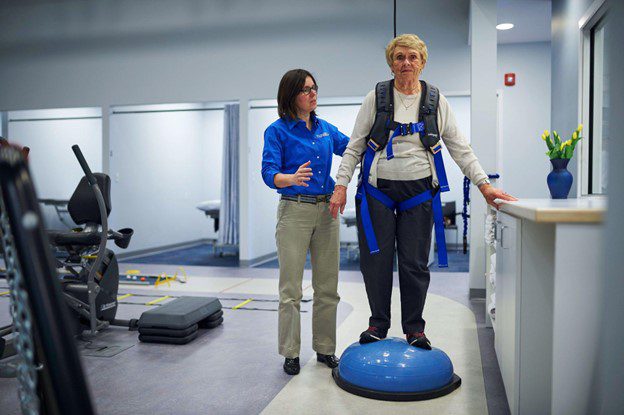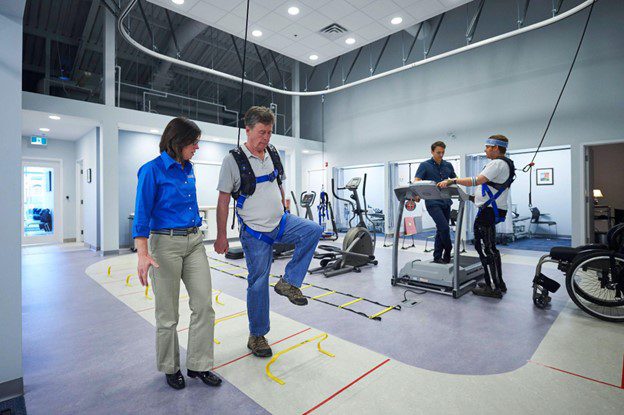How to Start a Balance Program for Physical Therapy

Starting a balance or vestibular program can separate your facility from your competition. Balance rehabilitation is an exercise based program used to improve balance and reduce problems related to dizziness. Many different types of patients can benefit from balance training, including:
- Elderly patients
- Orthopedic patients
- Pediatric patients
- Neuro patients
- And more
Every year, over 10 million patients visit a physician due to dizziness and balance issues. It is the most common complaint of patients over the age of 75, but patients of all ages can experience balance issues.
Who benefits from balance rehabilitation?
Patients typically referred for balance or vestibular rehabilitation therapy are those diagnosed with dizziness, vertigo, imbalance, Meniere’s syndrome, neck-related dizziness and migraines. Patients who have had a stroke or brain injury can also benefit from balance rehabilitation. If you have patients who are at risk of falling for any reason, implementing a balance program with specific equipment is very important.
Common symptoms that vestibular rehabilitation will help with:
- Dizziness or blurry vision
- Neck tightness, stiffness and/or pain
- Imbalance or the need to hold onto objects when walking
- Headaches
- Falls
- Vertigo/spinning
A physical therapist should evaluate the patient’s symptoms and review their medical history. The patient’s assessment will include all or part of the following areas:
- Balance
- Leg strength
- Flexibility
- Gait (how you walk)
- Visual stability and mobility
- Neck mobility
- Arm strength
- Positional testing, including an inner ear examination
After the review of a patient’s assessment, any deficits will be identified and a treatment plan is made to improve their function in activities of everyday living.
Assessing your patients’ balance
The intensity level of exercises is dependent on your patients’ abilities, disabilities, and treatment goals. The balance training exercises and intensity are determined with an assessment of the patient’s balance itself. This assessment is done in consideration of the presented symptoms and diagnosis. The assessment includes:
- An evaluation of the visual system (part of the central nervous system that is required for visual perception)
- An evaluation of the somatosensory system (network of neurons that help humans recognize objects, discriminate textures, generate sensory-motor feedback and exchange social cues)
- An evaluation of the vestibular system (motion, head position, and spatial orientation)
- An assessment of musculoskeletal element (your bones, cartilage, ligaments, tendons, and connective tissues)
- Balance evaluation systems test
- Other tests
Functional sequence of balance training
Balance training activities often start from lying to kneeling to sitting and then progresses to static and dynamic standing and walking. Progression from less to more demanding tasks is suggested and based on your patient’s current condition.
Balance training exercises are adapted to improve coordination and strength. In programs specifically designed for sport-injury prevention, the rate of movement is recommended to slowly progress toward the speeds used in the sport. Rehabilitating at the proper pace is important to avoid injury and make proper progress.
In consideration of older patients, who may be prone to falls due to impaired coordination and body instability, coordination exercises with low velocity, low impact, and high-interest level, which also provides a good training effect is preferred for most older persons.
What exercises and equipment should you use during balance rehab?
There are many different exercises patients can perform to improve their balance, and many pieces of equipment that help along the way. Some different exercises you may implement in your balance program include:
- Vision stability training
- These are exercises aimed at improving vision while the head is moving, generally while viewing a stationary object.
- Posture training
- This involves training your body to stand, walk, sit and lie in positions where the least strain is placed on supporting muscles and ligaments during these activities.
- Stretching and strengthening exercises
- Stretching refers to slow, sustained lengthening of muscles while strengthening refers to repeated muscle contractions until the muscle becomes tired.
- Balance retraining
- Balance training is a type of physical therapy designed to improve a patient’s steadiness and decrease his or her risk of falling.
- Walking exercises
- Walking exercises improve your overall strength and balance while you are walking. Some walking exercises you can expect your patient to perform during physical therapy are side-stepping, single leg calf raises, walking lunges, and more.
- Neck mobility/stretching exercises
- Neck mobility and stretching exercises are important to relieve stiffness that accompanies pain.
- Other general fitness exercises
No two exercise treatment plans are exactly alike.
Therapists should identify their patients’ deficits and adjust their treatment accordingly.
The equipment your facility has is very important to set yourself apart from your competitors. Some important equipment for your facility’s balance program include:
- Treadmills
- Treadmills are excellent for controlling weight, maintaining cardiovascular condition, rehabilitating minor injuries, and preventing the risk of re-injury.
- Balance Boards
- Balance boards, or wobble boards, are used for balance, athletic, postural, coordination, and falls prevention training.
- Cones
- Cones are a simple piece of equipment that can be used in many different types of ways such as challenging patients to walk forwards, walk around cones, side-step their way through the cones, and more.
- Stairs
- Training stairs provide a comfortable grip and safe, anti-slip platforms for rehabilitation purposes.
- BOSU Balls
- A BOSU ball is an inflatable, thick rubber dome on a flat, round platform, perfect for its versatility. It allows you to do familiar exercises like leg raises, lunges, abdominal crunches, push-ups, and stretches while focusing on balance by performing the exercises on an unstable surface.
What safety equipment should your facility have?
The safety of your patients and therapists should be at the top of your priority list. An injury to a patient or therapist could not only hurt your bottom line, but could also hurt your reputation as a physical therapy facility. It is extremely important to protect your patients from falls and injuries. Solo-Step offers equipment like the overhead track and harness system to protect your patients from falls. Some patient benefits of our overhead track and harness system include:
- Eliminates the fear of falling down
- Gives patients a boost of confidence
- Allows patients to challenge themselves with advanced therapies
- Creates a safe environment for balance, strength, and gait training
- 100% safety from fall related injuries
Many different facilities have incorporated a balance program with the Solo-Step overhead system. With the Solo-Step overhead track and harness system, facilities are able to offer their patients free balance assessments, where patients can test their balance in order to see if balance or vestibular therapy may help their conditions.
To learn more about the Solo-Step overhead track and harness system, please visit: https://solostep.com/
How can the Solo-Step help your patients’ gait disorder?
Causes of walking/gait disorders can range from arthritis to a neurological condition to something as simple as ill-fitting shoes. The variety of gait disorders call for different treatments.
Gait refers to a person’s pattern of walking. Walking involves balance and coordination of muscles so that the body is propelled forward in a rhythm, called the stride. There are many different possibilities that may cause an abnormal gait. Some common causes are:
- A degenerative disease (such as arthritis)
- An inner ear disorder
- Stroke
- Foot conditions
- A neurologic condition
- Something as simple as the wrong size of shoes
There are many different types of gait disorders that patients may experience. The chance of a gait disorder increases with age, as older people tend to experience more conditions that cause abnormal gait. For instance, older people typically have weaker muscles, delayed reaction and less muscle coordination than younger people.
The Solo-Step is a great gait system for therapy that allows the therapist to step back and view the patient’s total body alignment, making therapy easier and safer for both the patient and therapist. A facility will benefit from using the Solo-Step balance system for gait and balance training. This means you do not have to worry about a patient falling, because they are connected to an aluminum track by harness and lanyard.
How long is a typical balance rehabilitation program?
You would typically see a patient 1 to 2 times per week for 6 to 8 weeks. This varies based on the patient’s diagnosis, severity of symptoms, and response to therapy. Some patients may be seen for only 1 to 2 sessions, while other patients may need continued treatment over an extended period of time. Combining safety equipment like the Solo-Step overhead track and harness system with exercise equipment has shown to expedite the process for many patients.
What type of recovery/outcome can your patients expect from balance rehabilitation?
If you are considering starting a balance program at your facility, here are are the thinks you need to know. Overwhelming evidence has proven that balance therapy is effective in improving various symptoms in conditions including unilateral vestibular hypofunction, chronic dizziness, vestibular migraine and tension type headaches, PPPD, concussion and many others.
Most patients should expect improvement in their condition as long as they stick to their therapy schedule and continue incorporating what they have learned after they are done with physical therapy.
Expected balance rehabilitation outcomes include:
- Decreased risk of falling
- A decrease in dizziness symptoms
- Improved balance
- Increased body strength
- Return to prior level of movement/function
- Increase in confidence in ability to perform daily activities
- Improved neck motion & reduced symptoms
- Decreased nausea or vomiting
- Improved focus or concentration and memory
- Less fatigue and improved sleep
- Improved ability to stabilize gaze or vision and ability to track or focus on objects near and far
- Increased confidence to return to desired activities and hobbies
To learn how you can increase your patients confidence during physical therapy, click here!
For more information on the innovative and affordable Solo-Step patient safety and balance support system, CONTACT US TODAY!

